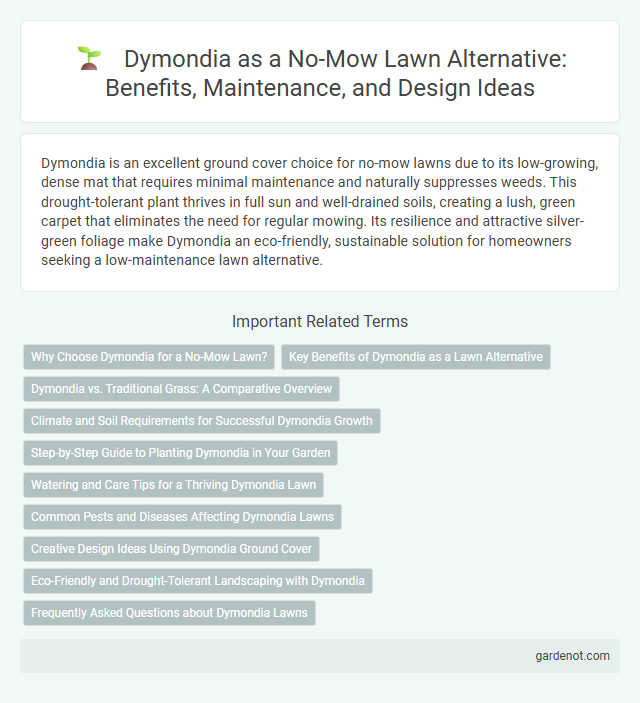Dymondia is an excellent ground cover choice for no-mow lawns due to its low-growing, dense mat that requires minimal maintenance and naturally suppresses weeds. This drought-tolerant plant thrives in full sun and well-drained soils, creating a lush, green carpet that eliminates the need for regular mowing. Its resilience and attractive silver-green foliage make Dymondia an eco-friendly, sustainable solution for homeowners seeking a low-maintenance lawn alternative.
Why Choose Dymondia for a No-Mow Lawn?
Dymondia is an ideal choice for a no-mow lawn due to its drought tolerance and low maintenance requirements, significantly reducing water usage and upkeep time. Its dense, creeping growth habit forms a lush, weed-resistant ground cover that maintains a neat appearance year-round without the need for mowing. This drought-resistant plant is also salt-tolerant and thrives in both sun and partial shade, making it versatile for various landscapes and climates.
Key Benefits of Dymondia as a Lawn Alternative
Dymondia offers excellent drought tolerance and requires minimal water, making it an eco-friendly lawn alternative that conserves resources. Its dense, low-growing foliage suppresses weeds effectively while providing a soft, carpet-like surface ideal for foot traffic. This resilient groundcover thrives in full sun and poor soils, reducing maintenance costs and eliminating the need for regular mowing.
Dymondia vs. Traditional Grass: A Comparative Overview
Dymondia offers a low-maintenance, drought-resistant alternative to traditional grass, thriving in sandy or poor soils where typical lawns struggle. Unlike conventional turf, Dymondia requires minimal watering, mowing, and fertilizing, making it an eco-friendly choice that reduces water consumption by up to 50%. Its dense, mat-forming growth pattern effectively suppresses weeds, providing a durable ground cover that maintains its green color year-round in Mediterranean and arid climates.
Climate and Soil Requirements for Successful Dymondia Growth
Dymondia thrives in Mediterranean and coastal climates, tolerating heat, drought, and mild frost, making it ideal for low-water landscapes. It prefers well-drained sandy or loamy soils with a neutral to slightly alkaline pH, ensuring optimal root development and growth. Avoid heavy clay or waterlogged soils to prevent root rot and promote healthy, dense ground cover.
Step-by-Step Guide to Planting Dymondia in Your Garden
Dymondia, a low-maintenance ground cover ideal for no-mow lawns, thrives best when planted in well-drained soil with full sun to partial shade exposure. Begin by clearing the area of weeds and debris, then space Dymondia plugs or runners about 6 to 12 inches apart to allow for natural spreading. Water thoroughly after planting and maintain consistent moisture for the first few weeks to ensure successful establishment and rapid ground coverage.
Watering and Care Tips for a Thriving Dymondia Lawn
Dymondia thrives with minimal watering, requiring only occasional deep irrigation every 10 to 14 days during dry spells to maintain healthy growth. Well-drained soil is essential to prevent root rot, while occasional light fertilization with a balanced, slow-release fertilizer supports vibrant, dense coverage. Mowing is rarely necessary, but if needed, trim to a height of 1 to 2 inches to preserve its low-growing, no-mow lawn characteristics.
Common Pests and Diseases Affecting Dymondia Lawns
Dymondia lawns are relatively pest-resistant but can occasionally suffer from infestations of whiteflies and aphids, which cause yellowing and distorted leaves. Fungal diseases such as rust and leaf spot may develop in overly moist conditions, leading to unsightly brown patches. Proper spacing, adequate sunlight, and well-drained soil significantly reduce the risk of pest and disease outbreaks in Dymondia ground cover.
Creative Design Ideas Using Dymondia Ground Cover
Dymondia ground cover offers a drought-tolerant, low-maintenance solution ideal for no-mow lawns, providing a lush carpet of silver-green foliage that thrives in full sun and partial shade. Its creeping habit allows creative design possibilities like edging walkways, filling in gaps between stepping stones, or creating living mosaic patterns that reduce soil erosion and suppress weeds. Combining Dymondia with contrasting succulents or ornamental grasses enhances texture and visual interest while maintaining an eco-friendly, water-wise landscape.
Eco-Friendly and Drought-Tolerant Landscaping with Dymondia
Dymondia, a low-growing ground cover native to South Africa, excels in eco-friendly, drought-tolerant landscaping by minimizing water usage and reducing lawn maintenance. Its dense, silver-green foliage suppresses weeds naturally, promoting a sustainable, no-mow lawn alternative ideal for arid climates. Incorporating Dymondia supports water conservation efforts and enhances soil health, making it a smart choice for environmentally responsible landscaping.
Frequently Asked Questions about Dymondia Lawns
Dymondia is a drought-tolerant ground cover ideal for no-mow lawns, thriving in full sun to partial shade and requiring minimal water once established. It grows low and dense, effectively suppressing weeds and creating a soft, carpet-like lawn alternative suitable for foot traffic. Common questions include its maintenance needs, compatibility with various soil types, and its resilience to pests and foot traffic.
Dymondia Infographic

 gardenot.com
gardenot.com